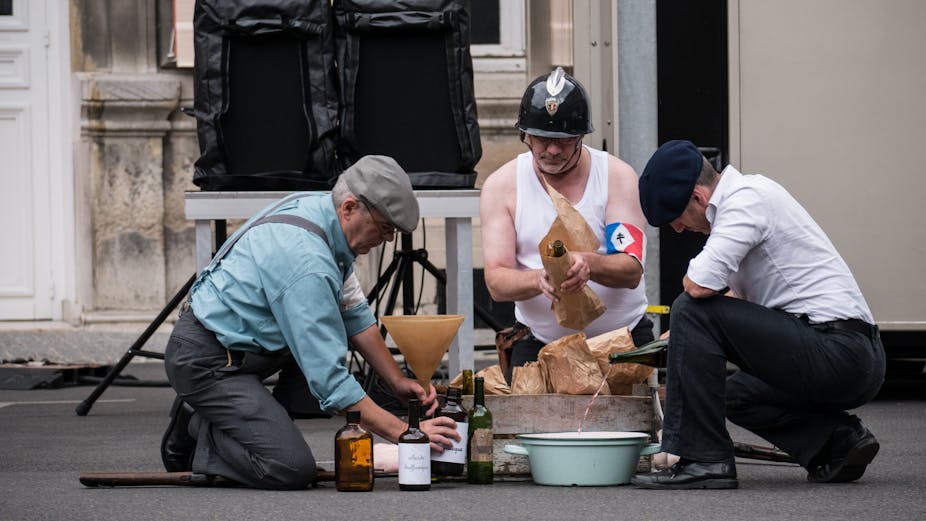The petrol bomb – or “Molotov cocktail” – is an iconic symbol of 20th-century political violence. Simple, cheap and effective, it has become a staple feature of protest, riot and rebellion; a weapon of choice for the discontented masses. But what are its origins, and who can be credited with its invention?
This is a question with no simple answer. Incendiaries of varying complexity have been used in warfare since ancient times. Indeed, the use of fire as weapon is referenced among the earliest books of the Bible. It should come as no surprise then, that the petrol bomb has many ancestors, with various earthenware incendiary projectiles recorded in use as early as the 9th century BC.
Looking to more recent times, it is clear that the petrol bomb also has more immediate forerunners in the 19th century. At the very least, the basic concept was prefigured in the spectre of the Pétroleuses, an imaginary body of working-class women accused of starting the fires that devastated Paris in the final days of the commune in 1871.
Descriptions of these phantom arsonists typically spoke of bottles of petrol and burning rags being thrown through cellar windows. For the most part, the fires had actually been started by the soldiers of the commune, using more traditional methods of arson.

Nevertheless, the petrol bomb as we know it today – a glass bottle or jar, filled with a simple incendiary mixture, and fixed with a basic fuse or wick to facilitate ignition upon breakage – is commonly believed to have originated during the Spanish Civil War (1936–39), where it was used by both nationalists and republicans as an anti-tank weapon.
Those early examples were crude and remarkably unstable. As one English veteran of the International Brigade later commented: “At least 10% of those who try these nasty things are likely to burn themselves quite badly.”
A more refined, mass-produced, version was subsequently developed by the Finnish Army for use against soviet tanks during the Winter War (1939–40). Here, it attracted more widespread attention, and earned an almost mythical status in the narrative of Finland’s surprise victory over the Red Army.
This was also the conflict in which it gained the nickname “Molotov cocktail”, a mocking reference to the then soviet foreign minister, Vyacheslav Molotov.

Thereafter, the concept quickly spread. In 1940, the British started work on a version with a self-igniting mixture for use by the home guard. In the 1950s, it was again employed against the Red Army by anti-communist resistance groups, most notably during the Hungarian Revolution (1956). Since then, its frequent replication has seen it pass into the realm of common knowledge.
Yet this is not so much an origin story as a narrative of how the petrol bomb has become embedded in popular consciousness. Indeed, it is clear that the device – in all its fundamental aspects – was in use much earlier than the Spanish Civil War.
A case in point is the Irish revolution (1916–23), where it may have been in use as early as May 1920. That month, members of the Irish Republican Army (IRA) used bottles of petrol and paraffin to set fire to a police barracks in Limerick. But although some of those involved in the attack later likened their actions to the use of Molotov cocktails, this is somewhat misleading.

There is little to suggest that these projectiles carried a fuse or wick. Rather, they were used to spread accelerant across the roof. This became a common tactic thereafter.
By 1922, there is irrefutable evidence of the use of petrol bombs by the IRA; this time along the newly created Irish border. Contemporary documents reveal that local units – under the leadership of future Irish politician and international statesman Frank Aiken – had evolved their own form of the now familiar device, and were using it regularly in operations ranging from sectarian attacks on civilian homes to ambushes against the police and military.
It was especially valued for its ability to “make an oven of an armoured car” while avoiding the sort of civilian casualties that could result from the use of conventional explosives.
The novelty of the concept is clear from a painstaking third-party description of the device submitted to Aiken’s superior officers in September 1922:
It consists of a bottle containing a mixture – ½ petrol, ½ paraffin, surrounded by a rubber band which holds in place a piece of fuse (4 sec) at either end of which is a safety match head. One end of the fuse is lighted and by the time the bottle strikes the objective the other end ignites causing the mixture to go on fire.

Although improvised incendiaries were nothing new to the IRA, their past efforts had tended to be more sophisticated, employing complex chemical mixtures and intricate hand-grenade constructions.
Whereas the contrasting simplicity of Aiken’s petrol bomb should have made it an asset, in reality it only served to marginalise it. His superiors simply did not understand the device:
I doubt that it will have such an effect on an armoured car. What is to prevent the bottle breaking before the mixture takes fire?
Consequently, there were no attempts to encourage its use beyond Aiken’s unit, and it quickly fell from memory when the conflict ended in 1923.
This surely is only one of many largely forgotten episodes in the history of the petrol bomb. And therein lies the difficulty of the question posed at the outset of this article.
Something so simple has undoubtedly been “invented” many times over.
Over the coming months, we’ll be running pieces looking at the history and nature of violence.

